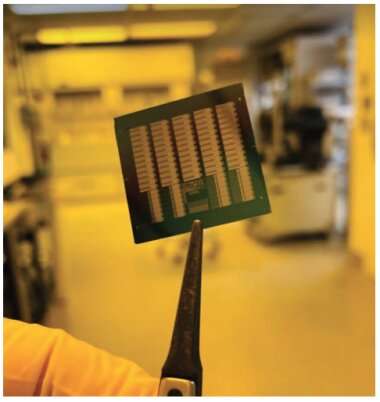A better photon detector to advance quantum technology

A team of researchers has developed an on-chip photon-counting device that could significantly advance numerous applications of quantum technology.
The laboratory of Hong Tang, the Llewellyn West Jones, Jr. Professor of Electrical Engineering, Applied Physics & Physics, has developed the first realization of an on-chip photon-number-resolving (PNR) detector that can resolve up to 100 photons at a time. This detector shows its power in resolving the photon statistics of a light pulse. The results are published in Nature Photonics.
Photon-number-resolving (PNR) detectors are considered the most desired technology for measuring light. With very high sensitivity, they can resolve the number of photons even in an extremely weak light pulse. They’re essential to a vast range of quantum applications, including quantum computing, quantum cryptography and remote sensing. However, current photon counting devices are limited in how many photons they can detect at once—usually only one at a time, and not more than 10.
“The problem is that if you have more than one, the detector will be saturated, so you cannot tell how many photons you have,” said co-lead author Yiyu Zhou, a postdoctoral associate in Tang’s lab.
The device from the Tang group, though, not only advances PNR capability by up to 100, but also improves by three orders of magnitude on the counting rate. It also operates at an easily accessible temperature.

Because of this, the device allows for a broader range of applications, Tang said, “especially in lots of fast-emerging quantum applications, such as large-scale Boson sampling, photonic quantum computing, and quantum metrology.”
The complexity of the device required years of design and fabrication, and then also to verify its performance.
To build on their work, the researchers plan to make the device smaller and increase the number of photons it can detect. That could include using different dielectric material to boost its photon number resolution to more than 1,000.
Further, they want to integrate the detector with on-chip quantum light sources. Conventional detectors are designed to be interfaced with an optical fiber, which can lead to signal loss.
“If we can integrate everything together, we would have lower loss, and a higher fidelity of measurement,” said Risheng Cheng, a former postdoctoral associate in Tang’s lab and currently a research scientist at Meta.
More information:
Risheng Cheng et al, A 100-pixel photon-number-resolving detector unveiling photon statistics, Nature Photonics (2022). DOI: 10.1038/s41566-022-01119-3
Citation:
A better photon detector to advance quantum technology (2023, January 4)
retrieved 4 January 2023
from https://phys.org/news/2023-01-photon-detector-advance-quantum-technology.html
This document is subject to copyright. Apart from any fair dealing for the purpose of private study or research, no
part may be reproduced without the written permission. The content is provided for information purposes only.
For all the latest Science News Click Here
For the latest news and updates, follow us on Google News.

